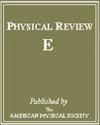玻璃形成液体中的玻璃动力学:甲苯的第一性原理研究。
IF 2.2
3区 物理与天体物理
Q2 PHYSICS, FLUIDS & PLASMAS
引用次数: 0
摘要
从微观上理解液体在冷却至玻璃化转变时粘度急剧增加的现象,是凝聚态物理学中一个尚未解决的重大问题。在这里,我们使用机器学习方法,以第一原理的精度加速了对玻璃化物甲苯的分子动力学模拟。我们发现,粘度的增加与动态相关分子 N^{*} 数量的增加密切相关。玻璃态动力学的某些标志性特征(如物理老化)也与 N^{*} 有关,而其他特征(如弛豫伸展)则与 N^{*} 无关。本文章由计算机程序翻译,如有差异,请以英文原文为准。
Glassy dynamics in a glass-forming liquid: A first-principles study of toluene.
The microscopic understanding of the dramatic increase in viscosity of liquids when cooled toward the glass transition is a major unresolved issue in condensed matter physics. Here, we use machine learning methods to accelerate molecular dynamics simulations with first-principles accuracy for the glass-former toluene. We show that the increase in viscosity is intimately linked to the increasing number of dynamically correlated molecules N^{*}. While certain hallmark features of glassy dynamics, like physical aging, are linked to N^{*} as well, others, like relaxation stretching, are not.
求助全文
通过发布文献求助,成功后即可免费获取论文全文。
去求助
来源期刊

Physical Review E
PHYSICS, FLUIDS & PLASMASPHYSICS, MATHEMAT-PHYSICS, MATHEMATICAL
CiteScore
4.50
自引率
16.70%
发文量
2110
期刊介绍:
Physical Review E (PRE), broad and interdisciplinary in scope, focuses on collective phenomena of many-body systems, with statistical physics and nonlinear dynamics as the central themes of the journal. Physical Review E publishes recent developments in biological and soft matter physics including granular materials, colloids, complex fluids, liquid crystals, and polymers. The journal covers fluid dynamics and plasma physics and includes sections on computational and interdisciplinary physics, for example, complex networks.
 求助内容:
求助内容: 应助结果提醒方式:
应助结果提醒方式:


